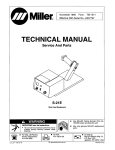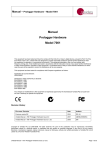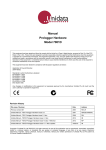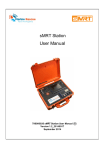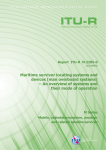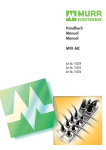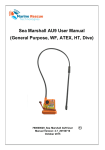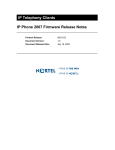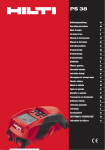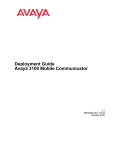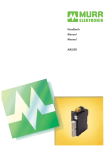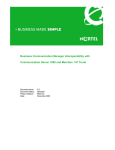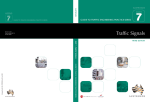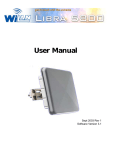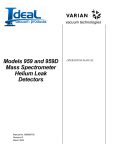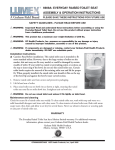Download PDF 404 kB
Transcript
BABT 755 A Guide to applying for Industry Canada Radio Equipment listing through BABT as an FCB Scheme BABT is the Telecommunications Certification body of TÜV SÜD © BABT 2009 Issue 8 Foreword This guide briefly explains the process and requirements for applications to BABT acting as an appointed FCB (or CAB) by Industry Canada. The scheme enables a manufacturer of product achieving listing to market the product within Canada. The scheme is operated under the BABT Certification Regulations and implements the Industry Canada requirements insofar as they apply to applications made to BABT. The current version of the BABT Certification Regulations may be found at www.BABT.com If there is any discrepancy between requirements found in this document and those found on Industry Canada Web sites the assumption should be that the Industry Canada website is more accurate. All BABT publications are available from: http://www.babt.com (See the download area in Information Services) or BABT Forsyth House Churchfield Road Walton on Thames Surrey KT12 2TD United Kingdom Tel: +44 (0) 1932 251200 Fax: +44 (0) 1932 251201 Email: [email protected] Forsyth House was previously Balfour House A Guide to applying for Industry Canada Radio Equipment Certification through BABT BABT 755 Issue 8 Page i of ii 1 Contents Introduction .................................................................................................. 1 1.1 1.2 2 Making an application ................................................................................. 1 2.1 2.2 2.3 3 4 5 6 Scope .................................................................................................................................... 1 Overview ............................................................................................................................... 1 Types of Application ............................................................................................................ 1 Who to apply to .................................................................................................................... 1 Who can apply ...................................................................................................................... 2 Progressing the Application ....................................................................... 2 Application for a Canadian Company Number .......................................... 2 Documentation Requirements for Certification ......................................... 3 Application Form for Certification .............................................................. 3 6.1 Application Form BABT 756 ................................................................................................ 3 6.2 Section A: Administrative Information................................................................................ 4 6.2.1 Applicant Information .................................................................................................. 4 6.2.2 Canadian Representative Address.............................................................................. 4 6.2.3 Other Contact Information ........................................................................................... 4 6.2.4 Manufacturer............................................................................................................... 4 6.3 Section B: Your Certification Requirements ...................................................................... 4 6.3.1 Type of Certification .................................................................................................... 4 6.3.2 Related Regulatory Processes .................................................................................... 5 6.4 Section C: Product Details................................................................................................... 5 6.4.1 Product Name and details ........................................................................................... 5 6.4.2 Brief description of the product.................................................................................... 5 6.4.3 Industry Canada Code ................................................................................................ 5 6.4.4 Product Installation Category ...................................................................................... 5 6.4.5 Radio Modules ............................................................................................................ 5 6.4.6 Ongoing Surveillance .................................................................................................. 5 6.4.7 Number of Radiators/Transmitters .............................................................................. 6 6.4.8 Features ..................................................................................................................... 6 6.4.9 Accessories ................................................................................................................ 6 6.5 Section D: Payment Details ................................................................................................. 6 6.6 Section E: Summary and Agreement .................................................................................. 6 7 Information on the Test Report Cover Sheet ............................................. 6 7.1 General .................................................................................................................................. 6 7.2 Administrative Information .................................................................................................. 6 7.2.1 Certification Body Number .......................................................................................... 6 7.2.2 Company Details ........................................................................................................ 6 7.2.3 Industry Canada Number (Company Number and UPN) ............................................. 6 7.2.4 Equipment Name & Model number ............................................................................. 7 7.2.5 Radio Standard Specification, Issue number, and Issue Date ..................................... 7 7.2.6 Test Lab Name, Address, IC ID .................................................................................. 7 7.2.7 Frequency Range ....................................................................................................... 7 7.2.8 RF Power .................................................................................................................... 7 7.2.9 Field Strength ............................................................................................................. 7 7.2.10 Occupied Bandwidth ................................................................................................... 7 7.2.11 Type of Modulation ..................................................................................................... 7 7.2.12 Emission Designator ................................................................................................... 7 7.2.13 Transmitter Spurious................................................................................................... 7 7.2.14 Receiver Spurious....................................................................................................... 7 7.2.15 Gain of Antenna(s) the device was certified with ......................................................... 7 7.2.16 Attestation ................................................................................................................... 7 8 Information to accompany an application ................................................. 7 8.1 General .................................................................................................................................. 7 i 8.2 8.3 8.4 8.5 8.6 8.7 8.8 8.9 8.10 8.11 8.12 8.13 8.14 8.15 8.16 9 A Guide to applying for Industry Canada Radio Equipment Certification through BABT BABT 755 Issue 8 Page ii of ii Exhibit 1: Label ..................................................................................................................... 8 Exhibit 2: Attestation Statement.......................................................................................... 8 Exhibit 3: External Photos .................................................................................................. 8 Exhibit 4: Block Diagram .................................................................................................... 8 Exhibit 5: Schematics and Bill of Material (BOM).............................................................. 8 Exhibit 6: Technical Report ................................................................................................. 8 Exhibit 7: Test Set-up Photographs .................................................................................... 9 Exhibit 8: Users Manual ...................................................................................................... 9 Exhibit 8A: Sales Literature ................................................................................................ 9 Exhibit 9: Internal Photographs.......................................................................................... 9 Exhibit 10: Tune up Information .......................................................................................... 9 Exhibit 11: RF Exposure ...................................................................................................... 9 Exhibit 12: Operating Description ..................................................................................... 10 Exhibit 12A: Antenna Details ............................................................................................. 10 Exhibit 13: Cover Letters ................................................................................................... 10 Correlation Of required information with type of application ................. 11 9.1 General ................................................................................................................................ 11 9.2 Single/Original Application ................................................................................................ 11 9.3 New Family ......................................................................................................................... 11 9.4 Addition to Existing Family ............................................................................................... 12 9.4.1 Where Original Approval was progressed by another FCB or by IC .......................... 12 9.5 Brandname/OEM Multiple Listings .................................................................................... 12 9.6 Reassessment/Modification .............................................................................................. 12 10 11 11.1 11.2 12 Certificates and Records ....................................................................... 13 Ongoing surveillance ............................................................................. 13 BABT Certified Quality System ......................................................................................... 13 Market Surveillance ............................................................................................................ 13 Modification and additions to Product Certification ............................ 13 12.1 Introduction ........................................................................................................................ 13 12.2 Class 1 Permissive Changes ............................................................................................. 13 12.3 Class 2 Permissive changes (C2pc) .................................................................................. 13 12.3.1 Introduction ............................................................................................................... 13 12.3.2 Required Exhibits ...................................................................................................... 14 12.3.3 Where Original Approval was progressed by another FCB or by IC .......................... 14 12.4 Other Technical Changes .................................................................................................. 14 Annex A Type of Radio Equipment and Applicable Standards ..... A-1 A.1 Type of Radio Equipment ................................................................................... A-1 A.2 Radio Equipment Standards............................................................................... A-3 Advanced Wireless Services Equipment Operating in the Bands 1710-1755 MHz and 21102155 MHz........................................................................................................................................ A-3 Fixed Wireless Access Equipment Operating in the Band 953-960 MHz................................... A-4 Annex B B.1 B.2 Proforma Letters ............................................................... B-1 Sample Agents Letter ......................................................................................... B-1 Confidentiality request and release Letter .......................................................... B-2 ii A Guide to applying for Industry Canada Radio Equipment Certification through BABT BABT 755 Issue 8 Page 1 of 14 1 Introduction 1.1 Scope This guide explains the process and requirements to apply for Industry Canada (IC) Radio listing through BABT as an FCB. 1.2 Overview Radio Equipment, intended to be marketed in Canada is required to be reviewed for compliance with Industry Canada requirements prior to entry to the market place. There are 2 categories of equipment which are defined Category 1 Equipment Category 2 Equipment All equipment detailed in either list must be tested to the appropriate standard. Equipment subject to standards listed under Category 1 requires independent approval by either Industry Canada or a Certification Body (CB within Canada, or FCB outside Canada). Equipment subject to standards listed under Category 2 may be marketed after a self assessment by the manufacturer and appropriate marking. BABT have been appointed as a FCB by Industry Canada and are authorised to approve equipment which is subject to an RSS standard found in the “Category I Equipment Standards List”. [Refer to Annex A.2 of this document for a list current at the start of 2006; for a list of standards current at the time of your application please refer to the Industry Canada web site]. BABT is not currently appointed for products subject to BETS standards. Compliance must be demonstrated to applicable Canadian Standards. The product must be tested in an IC listed test lab and the resulting test report presented with accompanying information to either a FCB or to Industry Canada itself. This guide explains the process wherein Approved Radio Equipment Listing may be obtained through BABT. New Technologies or Frequency Ranges Equipment using frequencies or modes outside the range of current standards or new Technologies requiring special test methods or relaxations from existing rules (Waivers) are outside the scope of all FCBs. Applications for approval of such equipment must be made directly to Industry Canada. Radio equipment imported only for demonstration or trial purposes does not require approval; however it may require a site licence. Please refer to Industry Canada for advice on such equipment. 2 Making an application 2.1 Types of Application The following different types of application which may be made: Application for a Company Number Application for an original Radio Listing Application for a change to an Authorized product or details listed on the grant Details of each of these are included in subsequent sections. 2.2 Who to apply to The application should be made direct to BABT in Walton-on-Thames either. By email to [email protected]; or Through BABT FTP server (available to regular clients, but still requires e-mail advice) By post (refer to foreword for address details; Note All documentation must be provided electronically) Due to the requirements on BABT to forward the data to Industry Canada in a timely manner we are unable to accept applications by phone or via the Fax. See also www.babt.com for information and news on the scheme. Testing and Application assembly Where you wish the BABT Testing facility to perform the required tests or use the service from the BABT ICM department to prepare and format the application you should apply separately for these services A Guide to applying for Industry Canada Radio Equipment Certification through BABT BABT 755 Issue 8 Page 2 of 14 2.3 Who can apply Applications can be made by or on behalf of both manufacturers and suppliers of equipment. Optionally, the applicant may in addition authorise BABT to liaise with another party acting on behalf of the applicant in matters relating to the application. 3 Progressing the Application When BABT has received your application and evaluated the initial information, we will: ask you to pay an application fee. The fee relates to the assessment of the application and may include additional elements where you request a grantee code, or provide documentation in paper form. Where you have identified a specific contact to whom to send the invoice it will be sent to them; otherwise it will be sent to the applicant; inform you of the BABT reference number assigned to your application. This number should be quoted in all further correspondence; review your application for completeness and consistency; advise either the applicant (or the technical contact where one is identified) of any concerns/omissions/shortfalls ; further work on that application may be suspended until a satisfactory response is received Where a significant number of exhibits are replaced BABT reserves the right to charge additional fees or cancel the application and require that a new application be submitted. Any fees due for the first application will still be due Where BABT is satisfied we will formally submit the listing to the Industry Canada web site and will advise you when this occurs; If there is a significant shortfall which either cannot be remedied, or where the remedy is not submitted in a timely fashion BABT may dismiss the application. 4 Application for a Canadian Company Number Every company applying to Industry Canada requires a unique Company Number (CN). Since the Company Number forms a part of the Industry Canada Certification/Registration number which must be referenced on the product label it should be obtained in advance of the product registration application. There are 2 ways you may obtain a Company Number: Apply for the CN via BABT in advance of the first product application; or Obtain it directly from Industry Canada. Note: Only Industry Canada can allocate the number, no FCB has such authority. Company Number Industry Canada allocate a Company Number for each Company and company location; where a company has multiple locations the first 4 Digits remain the same and a new final two “Alpha” Characters are allocated for the additional location (First is “A” through “Z” then “AA..AZ etc). The IC number associated with the product must reflect the number (including the Alpha part) of the location controlling the design and making the application A Guide to applying for Industry Canada Radio Equipment Certification through BABT BABT 755 Issue 8 Page 3 of 14 Flowchart of Application Progress Application Progress Do you have an Industry Canada Company Number ? No Obtain Company Code via BABT Yes BABT issue FCB Certificate Agree appropriate Type of Radio Equipment with BABT BABT file Notification to Industry Canada No Has testing Occured? Yes Is No testing appropriate to Equipment type ? Commission appropriate testing via TUV PS or other OATS listed lab Industry Canada add equipment to Approved Radio Equipment List Yes Assemble required exhibits End Apply to BABT with exhibits in electronic format No BABT Review application and exhibits Satisfactory? Yes 5 Documentation Requirements for Certification An application for certification must include a number of documents. The following document or document groups are required: Application Form Test Report Cover sheet(s) Technical Documentation to accompany the application. The requirements for all these are described the following sections. 6 Application Form for Certification 6.1 Application Form BABT 756 You should use the BABT form 756 for making applications for Radio Equipment Approval . A Guide to applying for Industry Canada Radio Equipment Certification through BABT BABT 755 Issue 8 Page 4 of 14 Industry Canada Application Requirements RSP-100 Clause 5.1 (b) requires “a covering letter explaining the type of certification services requested and a brief description of the radio apparatus”. Furthermore Industry Canada require Appendix A (or an equivalent document) to be completed and uploaded. Application form 756 when completed correctly meets these requirements. RSP-100 Clause 5.1 (b) requires the application include: Product Name Model Name(s) IC number Type of Service required Brief description of the product Where the application is for a Radio Module then either “open” or “Limited” Radio Module approval should be requested For Family Certificates the application shall additionally include: Description of the differences between models Justification why tests on one model are representative of the performance as a whole Additional Application Information: Refer to Exhibit 13 (Cover Letters) for additional information which may be required. The following information is required for each section. 6.2 Section A: Administrative Information 6.2.1 Applicant Information You should supply the Legal company name, address and contact details. Where the Address is not the same as that stored for the Industry Canada Company number then the application should include a letter stating the relationship between the two addresses (Normally Industry Canada require a separate “Alpha” suffix to the company number for each different location) 6.2.2 Canadian Representative Address It is a requirement that you have a representative in Canada who Industry Canada can request information and Market Surveillance samples. You must list the name of the company and location where the Representative in Canada is based. Where the Industry Canada Company Number associated with this location is known it should be listed. Canadian Companies may state “As applicant” if applicable Under Industry Canada company number For new locations of a known company please indicate “New Location” ; For New Companies to Industry Canada please indicate “New Company” Otherwise if the Company number is unknown state “Unknown” Acceptance Letter Before Industry Canada confirm the REL listing they check the validity of the identity of the Representative in Canada and their willingness to accept the responsibility in that role. This procedure is reduced where the application includes a letter (on suitably headed paper) from the Representative in Canada accepting that role for the product. (Note a general letter for All Radio Transmitting products from the applicants company is acceptable but it must be included with each application). 6.2.3 Other Contact Information Consultant /agent details (where you wish another party to be involved with this application). 6.2.4 Manufacturer You must list the name of the company and location in which the final assembly of the product takes place. Please include Country Name, and International Phone code in the information. Under Industry Canada company number For new locations of a known company please indicate “New Location”. For New Companies to Industry Canada please indicate “New Company”. Otherwise if the Company number is unknown state “Unknown”. 6.3 Section B: Your Certification Requirements 6.3.1 Type of Certification Please specify which Type of Certification you require. Please refer also to Industry Canada document RSP-100 for details of the individual types of Certification. A Guide to applying for Industry Canada Radio Equipment Certification through BABT BABT 755 Issue 8 Page 5 of 14 Single Certification: Where you have a single product (i.e. not a range of similar products) you should request a Single Certification. Additionally where you are submitting the “First” model in a family in a separate application to others you should select this option Re-assessment: Where you are making a Class II permissive change. Note: Class I Permissive changes do not have to be advised to Industry Canada Family Certification: Where you have a family of models which are “nearly identical” in design and construction then you may apply for family Certification. Each model must have a unique model number assigned. The following types of Family Certification may be requested New Family Certification Used for the first “set” of models for which certification is requested. Addition to Existing Family Certification Used to add new models to an existing certification (whether the existing Certification was for a family or as a single certification). Multiple Certification: You should select this option where you wish to list under your name and unique model number a certified radio equipment of an original equipment manufacturer. Note: Where the radio equipment is certified under a family certification you must confirm which family member(s) is/are being certified by you. 6.3.2 Related Regulatory Processes It is an Industry Canada requirement that where a product is telecommunications terminal equipment the manufacturer must establish compliance to CS-03 and issue a Declaration of Conformity for the product. Where the product also includes a Radio Transmitter the manufacturer must not upload the D of C directly but must instead send it to the FCB (or Industry Canada) to file in parallel with the Radio Approval Information. Please indicate whether your product is also telecommunications terminal equipment If so please enclose the D of C with the application in the Exhibit 2 Attestations folder and do not up-load it directly to Industry Canada. Note: Industry Canada have an additional filing charge for a DoC, This additional charge will be included in the BABT invoiced fee as BABT are required to pay this at the time of filing 6.4 Section C: Product Details The following details are required: 6.4.1 Product Name and details You should supply the product family name under which the product will be marketed, and the model name(s). These should match the names given on the product, in the User manual, and on the Test Report Cover sheet. You should still list the Model number even if it is the same as the product family (e.g. this is the only Model). 6.4.2 Brief description of the product This should be a brief description of the purpose and type of the product. For Multiple Listing applications the IC code of the original product should be listed under this section. 6.4.3 Industry Canada Code The Full Industry Canada Code comprises the Company Code which is allocated by Industry Canada followed by the Unique product number. The Unique product number is allocated by the manufacturer and must be unique when used with the company code. It may be up to 8 characters long and may only include the Alpha-numeric Characters A-Z, and 0-9. 6.4.4 Product Installation Category Please indicate the intended installation category for your application. This information is needed as different RF requirements apply according to Installation category. 6.4.5 Radio Modules Where you application is for a radio module to be used in host products please complete this section. Note additional requirements apply to Radio Modules. Where you only intend to install in certain hosts or types of host please indicate the host or type of host. 6.4.6 Ongoing Surveillance BABT are required by Industry Canada to conduct surveillance on a percentage of products they have approved. Where you are manufacturing the product at a location covered by a BABT ISO9001, PQC or FQA certificate all surveillance requirements will be met during audit; otherwise you product will be subject to the BABT surveillance route and you may be required to supply a production sample to BABT for test. 6.4.7 A Guide to applying for Industry Canada Radio Equipment Certification through BABT BABT 755 Issue 8 Page 6 of 14 Number of Radiators/Transmitters For each transmitter to be approved under this IC code please list the type of radio (i.e. Bluetooth, RFID etc); the Industry Canada Type of Radio Equipment; the modulation types supported by that transmitter; Equipment Standards to which compliance will be shown; and the highest output power in Watts of that transmitter (where possible quote in conducted power, else please indicate if EIRP, ERP etc). This is used to confirm the correct standards and configurations have been tested and submitted. Please ensure that each entry is completed in full as some entries are mandated in RSP-100 Appendix A. 6.4.8 Features Please list any features which may have effect upon the regulated aspects. 6.4.9 Accessories Please list any accessories which may have effect upon the regulated aspects (e.g. Alternate Batteries, Headsets). 6.5 Section D: Payment Details Information related to your intended method of payment. Name or address to which invoices and accounts should be sent where the person or address differs from the Main contact listed previously (to be included with supporting information). Purchase Order or Credit Card details. Work is carried out on receipt of either payment in advance or a valid purchase order number. Clients applying directly to BABT (i.e. not through any other TUV Group office), who do not currently have approved credit facilities with either BABT or TUV Product Service UK must include a completed Credit Details Form with the application. Alternatively payment in advance is accepted. The appropriate forms may be downloaded from http://www.babt.com 6.6 Section E: Summary and Agreement This must be completed by the applicant named in section A1 as this forms the contract between yourself and BABT. It furthermore includes certain statements required by Industry Canada. Note: This may not be completed by an Agent. 7 Information on the Test Report Cover Sheet 7.1 General The application must be accompanied by one or more completed Test Report Cover Sheet/Performance Test Data sheets BABT Document BABT 758 is a pro forma Sheet which may be used for this purpose. Other equivalent sheets from Test Laboratories or applicants are also acceptable. For most applications a single (2-3 page) Test Report Cover sheet should be sufficient. However for multiple transmitter products, where OEM modules are being incorporated, or test data comes from more than one source, it may be more suitable to submit more than one sheet. Please take care to ensure the information is accurate as this document forms a major element in the notification to Industry Canada following approval. 7.2 Administrative Information The following Administrative information shall be provided 7.2.1 Certification Body Number Please insert the BABT Certification Body Number (6909A –UK0004). 7.2.2 Company Details This information must correlate with those held against the Company Number by Industry Canada; however the Contact name and number may vary. Variations in company name within a corporation must be noted with the relationship explained. Please include Country Name, and International Phone code in the information. 7.2.3 Industry Canada Number (Company Number and UPN) This is the Industry Canada (IC) number which will appear on the product. The main (or sole) Test Report Cover Sheet must list the same IC number as on the product label. Where already certified Radio modules are being included with the submission then the Test Report Cover Sheet from their A Guide to applying for Industry Canada Radio Equipment Certification through BABT BABT 755 Issue 8 Page 7 of 14 application may be used and refer to the IC number of the Radio module provided there is a covering letter justifying the use of the technical data related to the module in support of this application. 7.2.4 Equipment Name & Model number This information must match the data on the product. For Single Certifications it is preferred that a Model name is given; otherwise BABT will allocate one based on supplied information. For Family Certifications each model being included within the certification must be listed. 7.2.5 Radio Standard Specification, Issue number, and Issue Date This entry must list the full information for each Specification relevant to the product This information must represent the current standards applicable to the transmitters within the product. 7.2.6 Test Lab Name, Address, IC ID This information must be provided for each different test report source. The Industry Canada OATS registration ID used for the testing must be provided (Note: The alpha number may be replaced/supplemented by a numeric part where the Test Lab has (or had) more than one registered OATS facility. The details must match the information within the supporting Test Reports. 7.2.7 Frequency Range This should include for each supported transmitter the reported range from the test report; this should match any declared range in the User Documentation. Note: where the signal is channelised, list the middle frequencies of the outside channels being used. 7.2.8 RF Power List the highest output power for each transmitter. If the equipment supports multiple modulations list the highest power for each modulation. 7.2.9 Field Strength State the highest Field Strength for each transmitter. If the equipment supports multiple modulations list the Field Strength for each modulation. 7.2.10 Occupied Bandwidth State this for each Transmitter and Modulation. 7.2.11 Type of Modulation Each different type of modulation for each Transmitter should be listed. 7.2.12 Emission Designator Each relevant Emission Designator for each Transmitter and Modulation must be listed in full, 7.2.13 Transmitter Spurious List the worst case for each transmitter and Modulation supported. 7.2.14 Receiver Spurious List the worst case with all receivers and transmitters powered up but not active. 7.2.15 Gain of Antenna(s) the device was certified with Where the product may use different Antennas list the highest gain for each type of antenna used with each transmitter. 7.2.16 Attestation The Attestation must be signed by either the Applicant, or by a formally appointed Agent (Agent appointment letter is required). Please date the signature in dd/mmm/yyyy format (i.e. 23/Mar/2005 to avoid confusion between European and NA date conventions. 8 Information to accompany an application 8.1 General Please send all files electronically in Adobe Acrobat, PDF format with file size less than 3Mb. Due to the frequent commonality between applications for US and Canadian Approval the exhibit structure listed below uses the same numbering as for US applications with additional exhibit types for Canadian specific requirements. A Guide to applying for Industry Canada Radio Equipment Certification through BABT BABT 755 Issue 8 Page 8 of 14 Please refer to the next section “Correlation of required Information with type of Application” for details of which exhibits are required for which types of application, and clarification of additional requirements. It is helpful if the number of files within a given Exhibit type is limited to the number necessary as each file reviewed has to be documented. For example please include photos (size permitting) in one file rather than supplying 6-8 individual files covering each face/pcb side, similarly Please supply a single File of all Schematics rather than separate files for each diagram 8.2 Exhibit 1: Label You should provide a copy of the label (or labels), with information related to how and where it is fixed on the equipment. As a minimum the Label should show the Industry Canada Number. Furthermore it is a requirement that the Equipment name and Model number appears on the product. This may either be demonstrated on a label in this exhibit, or clearly discernable in an external photograph. For Family listings copies of each different label holding the information must be provided. 8.3 Exhibit 2: Attestation Statement Where the product also supports one or more Telecommunications ports and is additionally Telecommunications Terminal Equipment then you should include the DoC in this exhibit. The DoC should include all the required wording as specified in Annex 1 of Industry Canada document DC-01. 8.4 Exhibit 3: External Photos External photos are required for all original filings. External Photos Photographs should be provided for everything accessible to the customer (e.g. top, bottom, both sides, front and back). BABT advise that colour photographs are used. Where a digital camera is used we advise that the resolution be sufficient to view the results clearly. Finally due to uploading constraints we strongly recommend that both external and internal photographs are supplied in separate documents to each other and the test reports For Family Listings each external variation must be recorded in a photograph (e.g. 16 key product with a 9 key variant would need an additional “front or top” photo but may not need other additional photos). 8.5 Exhibit 4: Block Diagram For complex, or multiple transmitter products a top level Block Diagram should be provided Additionally for each transmitter a block diagram should be provided showing the signalling paths, frequency of oscillator, and any tuning ranges. 8.6 Exhibit 5: Schematics and Bill of Material (BOM) Schematics for each transmitter should be provided. A top level BOM, and a BOM for each should also be provided. 8.7 Exhibit 6: Technical Report The Technical Report must come from a test company listed with Industry Canada. Please refer to RSS-Gen Clauses 3 and 4.1 for details of the requirements for Test Reports. Each test report should include Either a relevant Industry Canada No Name and address of manufacturer and applicant Device Name and model number Dated Measurements showing compliance with pertinent procedures Location of measurements Test Data signed by tester or person who supervised the tests Emission Designator for each different Modulation and frequency range supported by the device Details of the Gain and type of each Antenna tested with the device Standards identified Tested to applicable IC standards including a reference to current version and date of the Standard used List of test equipment and calibration dates Details of any non-standard test method used with a justification of validity Statement of power source for EUT (AC/DC Voltage AC frequency) Measurement facilities listed Calculations showing how results were converted A Guide to applying for Industry Canada Radio Equipment Certification through BABT BABT 755 Issue 8 Page 9 of 14 Descriptions of peripherals or accessories connected or installed during test Where more than one variant is covered by the test report a clear statement of which variant was tested; and the applicability of the results to the other variants FCC and Industry Canada Standards and test methods are largely aligned. Consequently test results obtained to appropriate FCC requirements may be used in support of applications for Industry Canada approvals. Where the product was originally tested to FCC Standard at a laboratory which has registered its OATS facility with Industry Canada then the test report to FCC standards may be submitted accompanied by either a supplementary Report, or a signed letter from an appropriate person within the test Laboratory detailing: A Reference to the appropriate Industry Canada Standard including version and issue level Cross Reference Table covering all the applicable IC Standards requirements against the Industry Canada Number of the Product Any other IC requirements not sufficiently covered in the FCC report. Note: Whereas the FCC do not require a review of Receiver Spurious Emissions for Certification Industry Canada include such requirements in their Radio standards and require FCBs to review the results. Where the results of Receiver testing for FCC (Part 15B) are in a separate test report this must also be provided for Industry Canada/FCB review. 8.8 Exhibit 7: Test Set-up Photographs These must be supplied as appropriate but may be included within Test reports. Diagrams are permitted in place of photographs. 8.9 Exhibit 8: Users Manual A copy (or draft) of the User Manual shall be provided. This should detail all accessories intended for use with the product. Furthermore it should, as applicable, contain the required statements detailed in: ICES-003 Annex RSS-GEN 7.1.5 Where required a copy of the installation and operating instructions must also be provided. Where this is in final draft this must be clearly identified and the final version must be supplied at a later date. This must contain some required wording and details of the intended use and installation rules. 8.10 Exhibit 8A: Sales Literature A copy (or draft) of the Sales Literature must be provided. This will be reviewed for accuracy with respect to the approved aspects of the product. 8.11 Exhibit 9: Internal Photographs Internal Photographs of the arrangement of PCBs and any antenna within the housing must be provided .For Family listings sufficient photos to cover each Family member must be provided. Internal photographs of both sides of each active PCB must be provided. These must be sufficiently clear to enable component values and identities to be seen. Refer to the note with Exhibit 3. 8.12 Exhibit 10: Tune up Information Where appropriate this shall contain the tune-up procedure over the power range or at specific operating levels. 8.13 Exhibit 11: RF Exposure All applications shall include two exhibits addressing RF exposure. The Application shall include a signed declaration of compliance to the requirements of RSS-102. For equipment where SAR/RF exposure evaluation has taken placethe following wording must be used ATTESTATION: I attest that the information provided in the RF Technical Brief is correct; that a Technical Brief was prepared and the information it contains is correct; that the device evaluation was performed or supervised by me; that applicable measurement methods and evaluation methodologies have been followed and that the device meets the SAR and/or RF exposure limits of RSS-102. Signature: ________________________________________ Date: ___________________ NAME (Please print or type):________________________________________________ TITLE (Please print or type): ________________________________________________ COMPANY (Please print or type): ________________________________________________ A Guide to applying for Industry Canada Radio Equipment Certification through BABT BABT 755 Issue 8 Page 10 of 14 For equipment which is SAR/RF exempt the following wording must be used ATTESTATION: I attest that the information provided in the RF Exemption Letter is correct; that the device evaluation was performed or supervised by me; that applicable measurement methods and evaluation methodologies have been followed and that the device meets the SAR and/or RF exposure limits of RSS-102. Signature: ________________________________________ Date: ___________________ NAME (Please print or type):________________________________________________ TITLE (Please print or type): ________________________________________________ COMPANY (Please print or type): ________________________________________________ The application shall also be accompanied by either: A complete RF Technical Brief cover sheet ( as required by RSS 102) ; A pro-forma RF Technical Brief cover sheet is available from the BABT web-site under Document number BABT 759. Where the transmitter is exempt from either SAR (Portable equipment) or RF exposure evaluation (Mobile equipment) according to RSS 102 clause 2.5 a signed letter from the applicant stating the particular exemption applicable to the transmitter; this shall include details of the transmitting frequencies, the highest measured output power, and the intended use ( General public or occupational). Note: There is no requirement to send a SAR or RF report to BABT. Where received we do not review these as the declaration is the responsibility of the applicant. Applications for Fixed locations shall either follow the above requirements or be individually licensed refer to BABT or Industry Canada where the individual licensing route is applicable. Refer RSS 102 for full details of RF exposure requirements 8.14 Exhibit 12: Operating Description Where applicable you should provide a brief description of the circuit functions along with a statement describing how the device operates. 8.15 Exhibit 12A: Antenna Details You should provide details of all Antennas intended for use with the Equipment. The information shall include the Antenna identity (e.g. Manufacturer part number/ commercial identity), the Antenna type and the highest Gain (over the applicable frequencies). Photographs should be provided showing the visible construction of all antennas included within the certification, and the placement of the antenna [either within the device or external to it]. Note these photos may be supplied either a part of this exhibit or the External or Internal photos {as appropriate} For Family Listings with internal Antenna photographs of each differing internal arrangement shall be provided. 8.16 Exhibit 13: Cover Letters These letters must be on company headed paper (or an Agents Company Headed paper where an agent is appointed) and shall be addressed to BABT FCB. This exhibit only applies where appropriate. Letters with the following information should be considered: Agent letter: Where you have identified an agent (Consultant) who you wish to be involved with the application you must provide a letter of authorisation on company headed paper (or equivalent). {Note: To permit BABT to interface with your agent you must also identify this person in the BABT application form. Confidentiality Letter: Where you have identified in your application that you wish certain aspects of your application to be treated with confidentiality you will need to provide a description of the relevant parts with a justification for the confidentiality. This letter must be on company headed paper (or an Agents Company Headed paper where an agent is appointed). Permit to Publish Letter: Where you invoke confidentiality you must also permit the FCB to publish details of the product with Industry Canada and may be combined with the Confidentiality Letter into a single document. Proformas of the above letters are included in this document in Annex B A Guide to applying for Industry Canada Radio Equipment Certification through BABT BABT 755 Issue 8 Page 11 of 14 Module Manufacturers Permit to use Results Letter: Where you are including test data obtained by another company (e.g. where you are integrating another manufacturers Radio Module into this equipment) you should include a letter from that company permitting use of those test results. This letter must be on the OEM company headed paper. Representative in Canada responsibility letter: Where you obtain such a letter (refer earlier for details) this must be included here. It must be on the appropriate paper and signed by an appropriate person within the company of the representative. Product Relationship Letter(s) : o Where testing has taken place on a product with a different name (e.g. A prototype name), IC number, or only under the FCC number then you should include a letter detailing the relationship of the tested product to the product name under which approval is being sought. This must include either a brief statement of the technical differences between the products or a statement that there are no differences. o Where you are including test data obtained by another company you should include a letter from that company permitting use of their results to obtain your approval. o For Family listings you should include a letter defining the relationship between each of the models requiring listings. This should include details of each model name and brief details of the differences from the most fully configured model. o Where you are including an already approved Radio Module into your product then a statement related to whether it has been modified, or used outside the original installation intent Models with multiple transmitters Where a product has more than one transmitter in the product then you must make a statement of which transmitters can transmit at the same time , and how the mechanism to inhibit simultaneous transmission operates Controlled Exposure: Where the “Controlled use” option is made for RF exposure then you should include a justification on why this applies and how it will be ensured Technical Descriptions: This could be used to clarification functionality to justify why tests do not apply, or otherwise assist the evaluation. You may submit any other letters which assist with the evaluation. 9 Correlation Of required information with type of application 9.1 General The above list of types of exhibit is not always required for all types of application. The following clarifies the required exhibits and some additional ones dependant upon the type of application. RSP-100 specifies most of the exhibits required for each type of application, BABT specify a few to clarify the evaluation. 9.2 Single/Original Application For a single Application all the exhibits listed in the previous section are required plus the BABT Application and the Test Report Cover sheet. 9.3 New Family For a New family all the exhibits required for a Single Application are required with the following additions/modifications All the model names must be listed in the Application form (BABT 756) and Test Report Cover sheet (BABT 758); Where any difference between models is external then External photos of each model Where any difference between models is internal then internal photos covering all models Cover Letter describing the differences between the models with particular emphasis differences which could effect the regulated characteristics; Labels for each model Where appropriate, testing covering each model (e.g. Spurious Emissions). A Guide to applying for Industry Canada Radio Equipment Certification through BABT BABT 755 Issue 8 Page 12 of 14 9.4 Addition to Existing Family The following exhibits are required A cover letter with the following o Details of the new Model number(s); o Reference to the current family IC number; o Description of the differences between the new model(s) and the existing approved models with particular emphasis on The radio frequency and RF output power The radio frequency circuitry The functional characteristics (insomuch as the effect regulated characteristics) o A Brief statement as to why the new model should qualify for family approval A completed BABT Application form (BABT 756) A completed Test Report Cover Sheet (BABT 758) Exhibit 1: Labels for the new Model(s) Where there are external differences between approved models and the additional model(s) then full Exhibit 3: External Photos for the new models Where the differences potentially effect any of the regulated characteristics then an Exhibit 6 test Report covering the appropriate testing Exhibits 8 (User Manual) and 8a (Sales Literature) where the introduction of the new model requires upissue of these documents [Note If the RF performance (e.g. SAR) or separation rules adversely change to those listed in the previous user manual then an up issued manual must be provided] Where there are internal differences between approved models and the additional model(s) then full Exhibit 9: Internal Photos Exhibit 11 RF Exposure: Both the Declaration and RF Technical brief [BABT 759] ) should be completed (as appropriate) for the new model(s) Other Cover Letters o All the normal Cover letters (e.g. Agent letters and Confidentiality requests) should be included where required. BABT are unable to carry over any of these from original applications. 9.4.1 Where Original Approval was progressed by another FCB or by IC Where the original approval was progressed through a different FCB or through Industry Canada the following exhibits should be enclosed: A copy of the Original (or latest) Approval Certificate for the product Additionally BABT may request copies of appropriate exhibits from the original (or latest) completed approval application. You may either: Judge what is appropriate and enclose them with your application to BABT; or Discuss and agree the required list with BABT in advance of your BABT Application; or Submit the normal documentation and await any requests for further documentation. 9.5 Brandname/OEM Multiple Listings The following Exhibits are required: OEM Manufacturers Permit to use Results Letter: You should include a letter from that company including o The original IC number and model(s) included in this permission. o A statement permitting use of their test results o A statement that the supplied product will not differ from their product o The letter must be on the OEM company headed paper. A completed BABT Application form (BABT 756) A completed Test Report Cover Sheet (BABT 758) Exhibit 1: Label for the new Model(s) Exhibits 8 (User Manual) and 8a (Sales Literature) Exhibit 11 RF Exposure : Both the Declaration and RF Technical brief [BABT 759] should be completed (as appropriate) for the new model(s) 9.6 Reassessment/Modification For details of Re-assessment please refer the section “Modifications and additions to Product Certification” A Guide to applying for Industry Canada Radio Equipment Certification through BABT BABT 755 Issue 8 Page 13 of 14 10 Certificates and Records Certificates are issued in the name of the Applicant Company which is thereafter referred to as the holder. Certificates also include the address of the holder (or an alternate address where identified within the application), data necessary for identification of the product, the reference to the technical data presented to BABT and any conditions for its validity. BABT maintain records of all the details on a certificate; of each submission and the resulting evaluation for 10 years after the last significant file activity. You shall maintain a record of all complaints and remedial actions relative to the Certified Product. These shall be made available to BABT on request. BABT will forward complaints about certified clients within an appropriate period of time to the certified clients in question. 11 Ongoing surveillance BABT are required to undertake surveillance on products for which we have recommended a grant. You must meet one of the two following requirements. 11.1 BABT Certified Quality System Where you manufacture your product at a facility and under a quality system which is covered by an appropriate BABT ISO 9001, PQC or FQA quality assurance system certificate with products of that broad technology type within the scope of quality system certification, then the manufacture of the product covered by the grant is considered to meet the surveillance requirements automatically. 11.2 Market Surveillance Where the manufacturing location is not covered by such a certificate you are liable to the market surveillance process. Under this BABT will at certain intervals send you an enquiry requesting the following information: Details of any changes significantly affecting the products design or specifications, or changes in standards which compliance of the product is certified, or changes in the ownership, structure or management, or any other circumstances indicating that the product may no longer comply with the requirements of the certification system. A copy of all advertising material currently in use bearing our logo. Details of a location where the use our mark on the product. may be evaluated A copy of your complaint log since the last surveillance for review BABT will review this information and will advise you of the outcome. BABT reserve the right to require a sample to be supplied for the purposes of additional testing. 12 Modification and additions to Product Certification 12.1 Introduction RSS-102 Clause 6 deals with changes to certified equipment. The following summarises the actions to be taken. Clause 5 covers the various types of Certification. 12.2 Class 1 Permissive Changes Class 1 Permissive Changes are changes which: Do not degrade the characteristics reported in the application to the FCB (or Industry Canada). Do not change external or internal mechanical characteristics enough to require new photographs to identify the equipment Do not change the model number Do not invalidate the previous attestation of compliance with RSS-102 ( RF Evaluation) No filing is required for such changes. 12.3 Class 2 Permissive changes (C2pc) 12.3.1 Introduction Class 2 Permissive Changes are changes which while still compliant: Degrade the characteristics reported in the application to the FCB (or Industry Canada). Do not change the model number Class 2 Permissive changes must submitted as a Reassessment application A Guide to applying for Industry Canada Radio Equipment Certification through BABT BABT 755 Issue 8 Page 14 of 14 Where the original Approval was made by another FCB or by Industry Canada a copy of the complete original application and exhibits should accompany the Class 2 Permissive change application but must be clearly identified and in a separate file structure. 12.3.2 Required Exhibits The following exhibit is always required: Exhibit 13: Covering letter describing the change This should detail the change to a degree sufficient to determine the required testing, and to justify which potential aspects are unchanged (e.g. A board re-layout which uses the original circuit should either state this, or also describe the additional modifications) . The following should be considered when generating the letter o Changes in Radio Frequency or RF output power o Changes in Functional capabilities o Changes in internal or external appearance o Where components ( e.g. Antennas, Batteries, etc) are involved the letter should specify whether such items are “Replacements” for the existing components, or whether they are “Alternatives” to those items o For Family Listings the model numbers affected by the change o A brief statement as to why the modified product still qualifies for certification o A justification for not applying tests (e.g. This Characteristic is not altered by the modification) and for the continuous overall compliance of the product. A completed BABT Application form (BABT 756) A completed Test Report Cover Sheet (BABT 758) Where the external appearance is changes then a revised complete full set of external photos should be submitted Where significant changes are made to the circuit or PCB layouts then updated Schematics (Exhibit 5) should be submitted. Where any of the Characteristics have degraded then a Test Report covering the appropriate testing should be submitted (Exhibit 6) Exhibit 11 RF Exposure: Both the Declaration and RF Technical brief [BABT 759] ) should be completed (as appropriate) for the new model(s) Where an alternate antenna is introduced or the Antenna has been changed then details of the new Antenna should be submitted in Exhibit 12A Other Cover Letters o All the normal Cover letters (e.g. Agent letters and Confidentiality requests) should be included where required. BABT are unable to carry over any of these from original applications. 12.3.3 Where Original Approval was progressed by another FCB or by IC Where the original approval (or the previous C2pc) was progressed through a different FCB or through Industry Canada the following exhibits should be enclosed: A copy of the Original (or latest) Approval Certificate for the product, Additionally BABT may request copies of appropriate exhibits from the original (or latest) completed approval application. You may either: Judge what is appropriate and enclose them with your application to BABT; or Discuss and agree the required list with BABT in advance of your BABT Application; or Submit the normal documentation and await any requests for further documentation. 12.4 Other Technical Changes Refer to BABT for details. A Guide to applying for Industry Canada Radio Equipment Certification through BABT BABT 755 Issue 8 Page A-1 of 4 Annex A Type of Radio Equipment and Applicable Standards A.1 Type of Radio Equipment The following is an extract from the Industry Canada website taken on 01 September 2009 Cellular Mobile AMPS (824-849 MHz) Cellular Mobile Dual-Mode AMPS/TDMA (824-849 MHz) Cellular Mobile Dual-Mode AMPS/CDMA (824-849 MHz) Cellular Mobile GSM (824-849 MHz) Cellular Base (824-849 MHz) Cellular Digital Packet Data (CDPD) Systems PCS Mobile (1850-1910 MHz) PCS Base (1930-1990 MHz) PCS Narrowband (901-902 MHz, 930-931 MHz and 940-941 MHz) Licence Exempt PCS Device (2 GHz) Mobile Earth Station Amplifier and/or Band Translator Land-Mobile Transmitter and Receiver (27.41-960 MHz) Fixed Radio Transmitter and Receiver (27.41-960 MHz) Maritime Radio Transmitter and Receiver (156-162.5 MHz) Land and Coast Transmitter (200-535 kHz) Coast and Ship Station SSB Transmitter and Receiver (1.605-28.0 MHz) AM Land-Mobile and/or Fixed Radio Transmitter and Receiver (1.705-50,0 MHz) Wireless Microphone (26.1-806 MHz) Wireless Video or Data Device (54-806 MHz) Digital Scanner Receiver Analogue Scanner Receiver LMS - Location and Monitoring Service (902-928 MHz) MCS - Multipoint Communication Systems (1427-1430 MHz, 1493.5-1496.5 MHz) Local Multipoint Communication System (28 GHz) Point-to-Point and/or Point-to-Multipoint Communication System (24,38, 57-64 GHz) Fixed Wireless Access System (3400 - 3700 MHz) Emergency Position Indicating Radio Beacon ELT - Emergency Locator Transmitter Personal Locator Beacon GMDSS - Global Maritime Distress and Safety System Cordless Telephone (900 MHz) Cordless Telephone (2.4 GHz) Remote Control Device Auditory Assistance Medical Telemetry Family Radio Service Device (FRS) Field Disturbance Sensor Spread Spectrum Device (902-928 MHz) Spread Spectrum Device (2400-2483.5 MHz) Spread Spectrum Device (5725-5850 MHz) Vehicle Device Local Area Network (LAN) Device Bluetooth Device Radar Device Security Device / Alarm System Video Device A Guide to applying for Industry Canada Radio Equipment Certification through BABT BABT 755 Issue 8 Page A-2 of 4 Cable Locating Device Receiver Cordless Telephone (5.2 GHz) RFID Device BETS-1, Low Power Announce Transmitters (525-1,705 kHz and 88-107.5 MHz) BETS-4, Television Broadcasting Transmitters BETS-5, AM Broadcasting Transmitters BETS-6, FM Broadcasting Transmitters BETS-8, FM Transmitters operating is small, remote communities BETS-9, Television Transmitters operating is small, remote communities Aeronautical (117.975 - 137 MHz) Wireless Headset Proximity Reader Modular Approval Wireless Computer Peripherals Wireless Audio device Wi-Fi device Low Power Device (902-928 MHz) Low Power Device (2400-2483.5 MHz) Low Power Device (5725-5875 MHz) General Mobile Radio Service Device (GMRS) Multipoint and Point-to-point Communications Systems (2150-2160/2500-2596/2686-2690 MHz) Wireless Communications Service (2305-2320 MHz, 2345-2360 MHz) WILAN Broadband Public Safety Equipment (4940-4990 MHz) Land Mobile and Fixed Equipment (1670-1675) Advanced Wireless Services(1710-1755 MHz and 2110-2155 MHz) RSS 182 Suffixes 182 Suffix] - (G) VHF radiotelephone / DSC / GMDSS compliant [182 Suffix] - (D) VHF radiotelephone / DSC / GMDSS compatible [182 Suffix] - (S) VHF radiotelephone / distress alert CH 70 [182 Suffix] - (V) VHF radiotelephone / voice only [182 Suffix] - (V) VHF radiotelephone / multiple watch [182 Suffix] - (n/a) VHF radiotelephone / voice only / IMO non-compliant [182 Suffix] - (G) VHF radiotelephone for survival craft / GMDSS [182 Suffix] - (G) Float-free VHF EPIRB / DSC [182 Suffix] - (A) AIS VHF transponder Class A [182 Suffix] - (B) AIS VHF transponder Class B RSS 287 Suffixes [287 Suffix] - (E1) EPIRB, float free [287 Suffix] - (E2) EPIRB manual activation [287 Suffix] - (PL) PLB [287 Suffix] - (A) ELT, automatically ejected [287 Suffix] - (AD) ELT, automatically deployable [287 Suffix] - (F) ELT, Fixed [287 Suffix] - (AF) ELT, automatic fixed [287 Suffix] - (AP) ELT, automatic portable [287 Suffix] - (W) ELT, water activated [287 Suffix] - (S) ELT, survival [287 Suffix] - (X) MSLD Ultra-Wideband (UWB) Device A Guide to applying for Industry Canada Radio Equipment Certification through BABT BABT 755 Issue 8 Page A-3 of 4 A.2 Radio Equipment Standards BABT is appointed to approve equipment using RSS standards in the Category 1 Equipment Standards list. BABT is not appointed for the BETS Standards. Where the standard number applicable to your apparatus does not appear in this list please contact BABT prior to submitting your application. The following is an extract from the Industry Canada website Checked 01 September 2009 BETS-1 BETS-4 BETS-5 BETS-6 BETS-8 BETS-9 RSS-102 RSS-111 RSS-112 RSS-117 RSS-118 RSS-119 RSS-123 RSS-125 RSS-129 RSS-131 RSS-132 RSS-133 RSS-134 RSS-135 RSS-136 RSS-137 RSS-138 RSS-139 Technical Standards and Requirements for Low Power Announce Transmitters in the Frequency Bands 525-1,705 kHz and 88-107.5 MHz Technical Standards and Requirements for Television Broadcasting Transmitters Technical Standards and Requirements for AM Broadcasting Transmitters Technical Standards and Requirements for FM Broadcasting Transmitters Technical Standards and Requirements for FM Transmitters Operating in Small Remote Communities Issue 1, November 1996 Technical Standards and Requirements for Television Transmitters Operating in Small Remote Communities -Evaluation Procedure for Mobile and Portable Radio Transmitters With Respect to Health Canada's Safety Code 6 for Exposure of Humans to Radio Frequency Fields RSS-111 - Broadband Public Safety Equipment Operating in the Band 4940-4990 MHz Land Mobile and Fixed Equipment operating in the Band 1670-1675 MHz Land and Coast Station Transmitters Using A1, A2, A3, A2H, or A3H Emissions Operating in the 200 - 535 kHz Band Land and Subscriber Stations: Voice, Data and Tone Modulated, Angle Modulation Radiotelephone Transmitters and Receivers Operating in the Cellular Mobile Bands 824-849 MHz and 869-894 MHz Annex A - Cellular System Mobile Station Land Station Compatibility Standard Addendum Supplement 1993-1 Amendment #2 Land Mobile and Fixed Radio Transmitters and Receivers, 27.41 to 960.0 MHz Low Power Licensed Radiocommunication Devices Issue 1, November 1, 1996 Issue 3 , June 2009 Land Mobile and Fixed Radio Transmitters and Receivers, 1.705 to 50.0 MHz, Primarily Amplitude Modulated 800 MHz Dual-Mode CDMA Cellular Telephones Zone Enhancers for the Land Mobile Service 800 MHz Cellular Telephones Employing New Technologies RSS-133 - 2 GHz Personal Communication Services 900 MHz Narrowband Personal Communications Services Digital Scanner Receivers Land and Mobile Station Radiotelephone Transmitters and Receivers Operating in the 26.960 - 27.410 MHz General Radio Service Band RSS-137 - Location and Monitoring Service (902-928 MHz) RSS-138 - Commercial Shipborne Radar in the 2900-3100 MHz, 54705650 MHz and 9225-9500 MHz Bands Advanced Wireless Services Equipment Operating in the Bands 17101755 MHz and 2110-2155 MHz Issue 1, November1996 Issue 1, November 1996 Issue 2, August 2005 Issue 1 November 1, 1996 Issue 3 June 2009 Issue 1 February 2008 Issue 2, March 30, 1974 Issue 2, August 19, 1990 October 22, 1983 September 1, 1990 June 12, 1993 Issue 2, August 24, 1996 Issue 9, June 2007 Issue 1, Revision 2, November 6, 1999 Issue 2, Revision 1, March 25, 2000 Issue 2, September 25, 1999 Issue 2, July 2003 Issue 2, September 2005 Issue 5, February 2009 Issue 1, Revision 1, March 25, 2000 Issue 2, June 2009 Issue 5, October 2002 Issue 2, February 2009 Issue 1, February 2004 Issue 2, February 2009 A Guide to applying for Industry Canada Radio Equipment Certification through BABT BABT 755 Issue 8 Page A-4 of 4 RSS-141 RSS-142 RSS-170 RSS-181 RSS-182 RSS-188 RSS-191 RSS-192 RSS-193 RSS-194 RSS-195 RSS-210 RSS-213 RSS-215 RSS-220 RSS-243 RSS - 287 RSS-Gen Aeronautical Radiocommunication Equipment in the Frequency Band 117.975-137 MHz Narrowband Multipoint Communication Systems in the 1427-1430 MHZ and 1493.5-1496.5 MHZ Bands Satellite Mobile Earth Stations Coast and Ship Station Single Sideband Radiotelephone Transmitters and Receivers Operating in the 1 605 - 28 000 kHz Band Maritime Radio Transmitters and Receivers in the Band 156-162.5 MHz Global Maritime Distress and Safety System (GMDSS) Local Multipoint Communication Systems in the 25.35-28.35GHz Band; Point-to-Point and Point-to-Multipoint Broadband Communication Systems in the 24.25-24.45, and 25.05-25.25 GHz and Point-to-Multipoint Broadband Communication Systems in the 38.6-40 GHz Bands Fixed Wireless Access Equipment Operating in the Band 3450 - 3650 MHz Multipoint and Point-to-Point Communication Systems (MCS) in the Fixed Service Operating in the 2150-2160 MHz, 2500-2596 MHz and 2686-2690 MHz Bands Fixed Wireless Access Equipment Operating in the Band 953-960 MHz Wireless Communications Service Equipment Operating in the Bands 2305-2320 MHz and 2345-2360 MHz Low Power Licence-Exempt Radiocommunication Devices (All Frequency Bands) 2 GHz Licence-Exempt Personal Communications Service Devices (PCS) Analogue Scanner Receivers RSS-220 - Devices Using Ultra-Wideband (UWB) Technology Active Medical Implant Communications System Devices in the 402-405 MHz Band Emergency Position Indicating Radio Beacons (EPIRB), Emergency Locator Transmitters (ELT), Personal Locator Beacons (PLB), and Maritime Survivor Locator Devices (MSLD) General Requirements and Information for the Certification of Radio Equipment Issue 1, Revision 1, February 2004 Issue 3, December 2007 Issue 1, Revision 1, November 6, 1999 Issue 1, April 1, 1971 Amendment, July 1987 Issue 4, September, 2003 Issue 1 (Provisional), August 24, 1996 Issue 3 April 2008 Issue 3, January 2008 Issue 1, July 2003 Issue 1 October 2007 Issue 1, January 2004 Issue 7, June 2007 Issue 2, December 2005 Issue 2, June, 2009 Issue 1, March 2009 Issue 2, November 2005 Issue 1 February 2007 Issue 2, June 2007 A Guide to applying for Industry Canada Radio Equipment Certification through BABT BABT 755 Issue 8 Page B-1 of 2 Annex B Proforma Letters B.1 Sample Agents Letter The following is a pro-forma for an Agent Letter. Where appropriate please submit a similar letter on headed paper as a cover letter exhibit. COMPANY LETTERHEAD (agent letter) Date (dd/mmm/yyyy) BABT FCB Forsyth House, Churchfield Road, Walton-on-Thames, Surrey, KT12 2TD, Dear Sir or Madame: We, (Name and Address of Firm, i.e. applicant), hereby authorize (Name [ company or individual] , address and phone) to act as our agent in all matters relating to applications for equipment authorization, including the signing of all documents relating to these matters. This authorization expires on (insert date [ recommend at least 6 months duration ] . Sincerely, Company Officer Telephone Number Email A Guide to applying for Industry Canada Radio Equipment Certification through BABT BABT 755 Issue 8 Page B-2 of 2 B.2 Confidentiality request and release Letter The following is a pro-forma for a confidentiality request and release Letter which is required in most cases. Where appropriate please submit a similar letter on headed paper as a cover letter exhibit. COMPANY LETTERHEAD (confidentiality and public release) Date (dd/mmm/yyyy) BABT FCB Forsyth House, Churchfield Road, Walton-on-Thames, Surrey, KT12 2TD, Dear Sir or Madame: Pursuant to RSP-100, Paragraph 10, we, (Name and Address of Firm, i.e. Applicant) hereby requests confidential treatment of information accompanying as outlined below: <<example: Schematics, Bill of Materials, Theory of Operation, Tune-up procedure >> The above materials contain trade secrets and proprietary information not customarily released to the public. The public disclosure of these matters might be harmful to the Applicant and provide unjustified benefits to its competitors. We, (Name and Address of Firm), hereby authorize BABT and Industry Canada to publish all or part of the following information on the IC website: Certification number; Company number; Previous certification number (if applicable); Company name; Company contact information (name, address, email, fax, phone; Manufacturer (name, contact person address, email, fax, phone; Representative in Canada; Model name and/or number as it appears on the product; Specification or standard code and issue number; Type of equipment (equipment category); Test Lab name, address, ID #, OATS filing reference number; Test Lab report number and date; List of accessories with which the equipment was tested; List of operational features; Frequency Range; Emission Designator(s); (Nature of signal(s); Type of information being transmitted; Details about the signal(s); Nature of multiplexing;) Bandwidth(s); Type of modulation(s); Field strength measured in microVolt per meter @ 3 meters if the antenna is integral to the device or conducted RF Power if the antenna is detachable; and Gain of antenna(s) the device was certified with. Sincerely, Company Officer Telephone Number Email
























